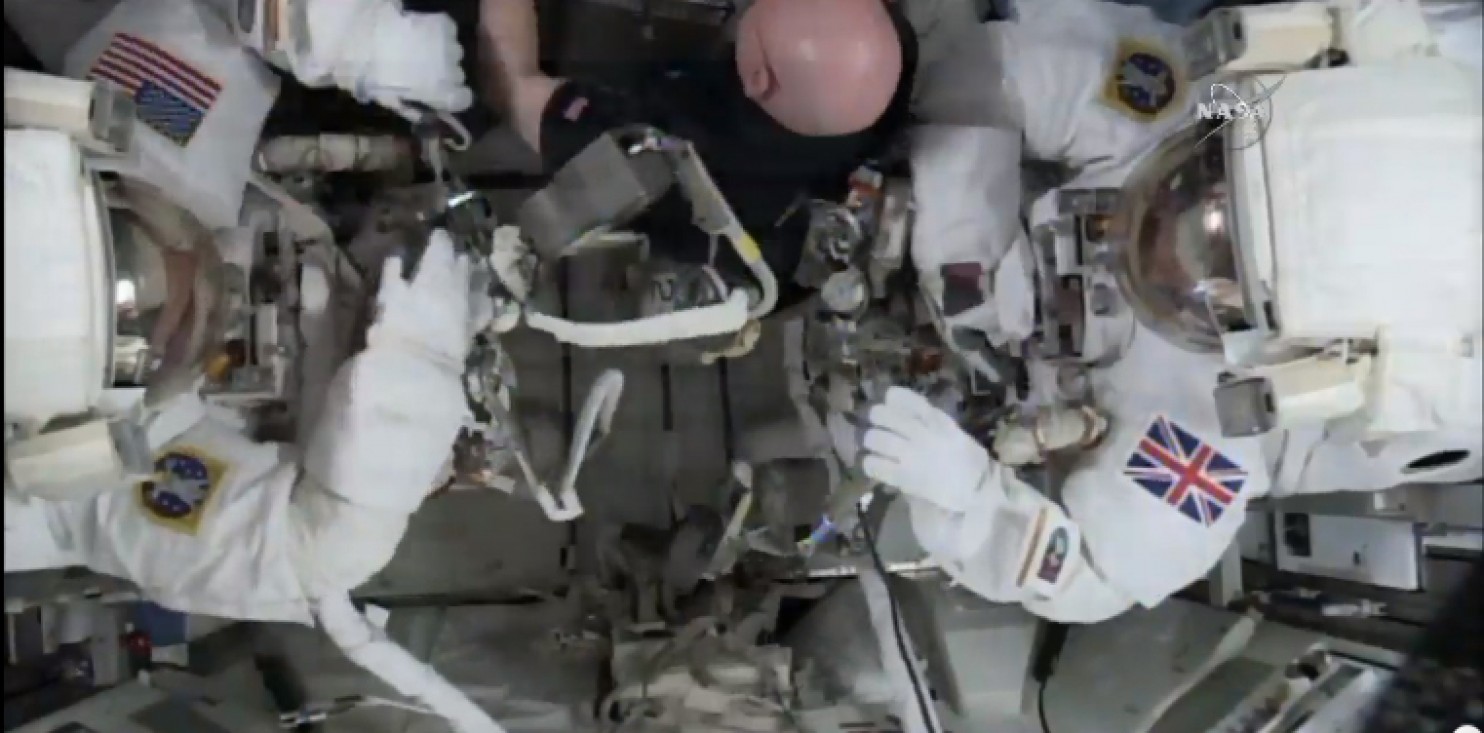
Two astronauts aborted their spacewalk Friday and hurried back into the International Space Station after water leaked into one of the men’s helmets in a scary repeat of a near-drowning 2½ years ago.
The trouble cropped up after the astronauts – including Britain’s 1st spacewalker – successfully restored full power to the space station.
NASA astronaut Timothy Kopra took everyone by surprise when he reported a small water bubble and a few minutes later, a film of water, inside his helmet. Mindful of another spacewalker’s close call in 2013, Mission Control terminated the planned six-hour spacewalk at the four-hour mark.
“So far, I’m OK,” Kopra assured everyone. Later, he said the water bubble was 4 inches long and getting thicker.
“I’m doing good,” he repeated on his way back inside.
Lead flight director Royce Renfrew, who called an early end to the spacewalk, stressed that the situation was not an emergency and insisted neither spacewalker was in danger. Indeed, Kopra took time to thank everyone for their help as the air lock was pressurized.
Almost exactly an hour after he first reported the problem, Kopra was safely back inside his orbiting home, along with Timothy Peake, who attracted his own headlines by becoming Britain’s first spacewalker Friday. Both men looked fine.
The astronauts waiting anxiously inside pulled off Kopra’s helmet, then measured the water that had leaked, apparently from the cooling loop in the suit. Space station commander Scott Kelly reported that he filled a syringe with about 15 cubic centimeters of water.
That’s nothing, NASA officials pointed out, compared with the 1 to 1½ liters of water that escaped into Italian astronaut Luca Parmitano’s helmet and suit in July 2013.
The cap that Kopra wore on his head, under his helmet, was moist, as were other parts of his suit. As for Peake’s suit, a quick look showed it to be dry save for a bit of moisture around the wrists.
Kopra and Peake completed their No. 1 job early on in the spacewalk. The pair quickly removed the voltage regulator that failed two months ago, slashing station power by one-eighth. The breakdown did not disrupt work 250 miles up, but NASA wanted the power grid fixed as soon as possible in case something else failed.
Working in darkness to avoid electrical shock from the solar power system, the astronauts quickly removed the bad unit and popped in a spare, both about the size of a 30-gallon aquarium. They had just 31 minutes to complete the job, the amount of nighttime on that particular swing around the world.
Following tests, Mission Control said the spare – dubbed Dusty for its 17-year tenure in orbit – appeared to be working properly.
Engineers suspect the original electronic unit suffered an internal electrical short. In the meantime, the station relied on the seven other power channels.
The action unfolded on the far reaches of the space station. The work site is about 200 feet from the astronauts’ exit, about as far as spacewalkers safely can go.
“Glad to see you both out there together on the tip of the world,” Mission Control radioed.
Peake, in particular, received a bounty of well wishes – from space as well as Earth. He became the first spacewalker to wear the Union Jack on the shoulder of his suit.
“We’re all watching, no pressure!” Former Beatle Paul McCartney said via Twitter. “Wishing you a happy stroll outdoors in the universe.”
Earlier, as Peake floated out, space station commander Scott Kelly called, “Hey Tim, it’s really cool seeing that Union Jack go outside. It’s explored all over the world. Now it’s explored space.”
Replied Peake: “It’s great to be wearing it, a huge privilege, a proud moment.”
Peake, a helicopter pilot chosen by the European Space Agency, is Britain’s first official astronaut.
A handful of previous spacewalkers held dual U.S.-English citizenship, but flew as Americans for NASA. The first British citizen to fly in space, chemist Helen Sharman, visited Russia’s old Mir space station as part of a private competition in 1991.
Peake and Kopra rocketed into orbit exactly one month ago aboard a Russian spacecraft.
Parmitano – another European Space Agency astronaut – came close to drowning when water leaked into his helmet from the cooling system of his undergarment in 2013. NASA added absorbent pads to the helmet and put in place other precautions for future spacewalks. Those pads and safety procedures came in handy Friday.
Parmitano’s spacewalking partner that day, NASA astronaut Chris Cassidy, rushed into Mission Control in Houston on Friday and offered assistance.
Cassidy, who’s now chief of NASA’s astronaut corps, said, at least, everyone now has “a good grasp” of what to heed and what to do. Engineers will scour the data in the weeks ahead to figure out what happened.
Filed Under: Aerospace + defense




